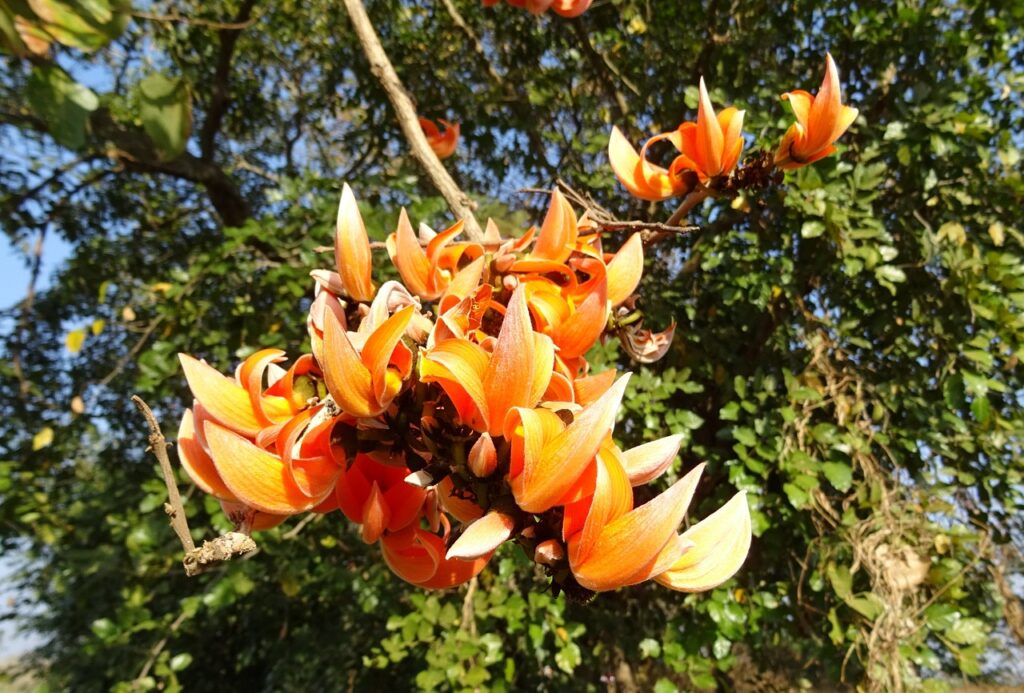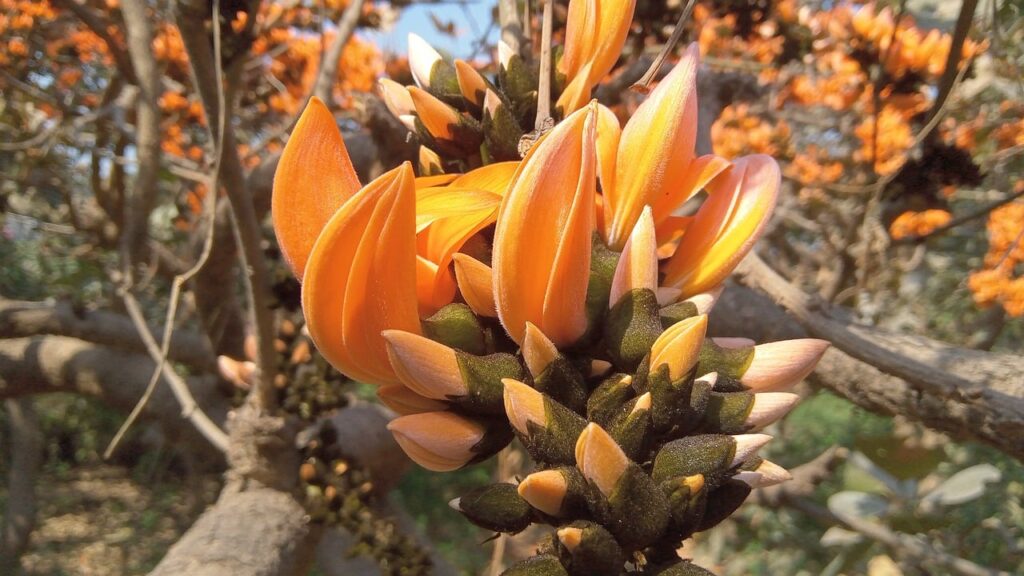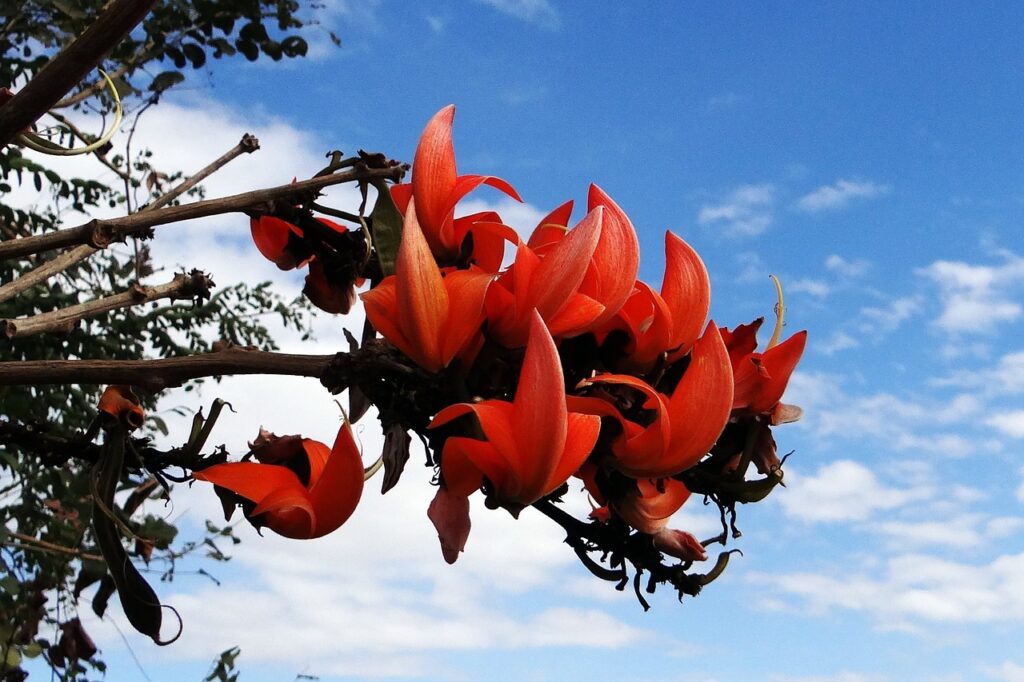An Overview of Palash
The Palash tree (Butea monosperma), also known as the Flame of the Forest, holds immense importance in Indian culture, Ayurveda, and ecology. Renowned for its vibrant orange-red flowers, Palash is celebrated for its uses in traditional medicine, rituals, and natural dye production. Its benefits include aiding digestion, boosting immunity, and treating skin ailments. The tree’s bark, leaves, and flowers are rich in therapeutic properties, making it valuable in holistic health. Beyond its medicinal value, Palash enhances soil fertility and supports biodiversity. This iconic tree symbolizes purity, vitality, and the harmonious coexistence of nature and humanity.

Table of Contents
Palash (Butea monosperma): the Flame of the Forest.
Have you ever been stopped in your tracks by a spectacle of pure, unadulterated natural beauty? A display so vibrant and fiery, it seems to ignite the very air around it? I’m referring to it, Butea monosperma, affectionately known as the Flame of the Forest.
This tree isn’t merely a botanical specimen; it’s a living testament to nature’s artistry, a cultural icon steeped in tradition, and a source of wonder for all who encounter it. In this expanded exploration, we’ll dive deep into the world of it, from its botanical intricacies to its place in history, traditional medicine, and the human imagination. We’ll look at scientific studies, Ayurvedic uses, and explore the plant’s many facets.
Botanical Grandeur: An Intricate Look at the Palash
Butea monosperma, is a deciduous tree of medium height, belonging to the Fabaceae family, a lineage that includes peas and beans. It is best known for its breathtaking floral display that earned it its poetic nickname, “Flame of the Forest.” During its blooming season, the tree appears to be engulfed in a fiery spectacle of orange-red flowers that cluster together at the end of branches, resembling flames reaching for the sky.

Each blossom has a distinctive structure: five petals – one standard (the banner), two lateral petals (the wings), and two curved (the keel) that all combine to create a very vibrant and recognizable blossom. The leaves of the tree are equally distinctive.
compound and trifoliate, with each of the three leaflets being broad and oval-shaped, presenting a dark green hue. During the dry winter months, the tree sheds its leaves, leaving it bare until the arrival of spring when the flowers burst forth. The tree reaches a height of about 40 to 50 feet, and with its striking features, it commands attention wherever it grows.
A Tapestry of Culture and Tradition: The Palash in Human Life
The tree holds a position of deep cultural significance, most notably in India. Its stunning blossoms are interwoven with countless festivals, religious rituals, and artistic practices.
In Hindu mythology, the tree is closely tied to Kama, the god of love, who is often depicted with arrows tipped with Palash blossoms. The flowers play an integral role in the celebration of Holi, the vibrant spring festival known for its use of color. It is also seen as an auspicious tree with many local traditions related to it as a symbol of good luck, prosperity, and purity. The rich tradition of its use spans generations across a variety of cultures.
The tree captivating beauty has inspired countless artists. The tree is a popular motif in Indian art, found in paintings, textiles, and handicrafts, where its image embodies passion, beauty, and the long-awaited arrival of spring.
Traditional Uses: A Legacy of Applications
- Natural Dyes: The most well-known use of it is the extraction of natural dyes from its flowers. These dyes produce a range of colours from yellow and orange to deep red, which are traditionally used to colour textiles, hair, skin, and food.
- Traditional Medicine: Various parts of the tree have been utilized in traditional medicine, where it has been used to treat various conditions, including digestive issues, skin diseases, and fevers. However, it is important to note that while the plant does have chemical compounds that suggest medicinal potential, many of the traditional uses have not been scientifically validated.
- Fodder and Fuel: The leaves are often utilized as fodder for livestock, while the wood serves as a fuel source in many regions. The wood is also used to create various tools and household items.
- Crafts and Tools: The tough, flexible parts of the tree, such as bark, seeds, and wood, have been used in crafts for ropes, baskets, and even disposable eating containers.
Scientific and Ayurvedic Insights: Exploring the Tree’s Potential
Scientific Research: Modern scientific research has begun to validate some of the traditional uses of it, although much of the plant’s potential remains to be explored. Some studies have demonstrated that the Palash contains various bioactive compounds, including flavonoids and tannins, which have shown antioxidant, anti-inflammatory, and antimicrobial properties in laboratory settings. However, clinical trials that test human subjects are necessary to fully confirm any medicinal benefits and the safety of these compounds when used in humans.
Ayurvedic Perspectives: In Ayurveda, the traditional system of medicine in India, it is valued for its balancing properties. The bark, seeds, flowers, and leaves are used to address various ailments. Ayurvedic texts describe the Palash as having a cooling and astringent effect, making it useful in treating conditions related to imbalances in the Pitta dosha, such as inflammation and skin problems.
It is also used to help promote digestive health and to help with wound healing. These applications, while traditional, should always be performed with the guidance of a trained professional.
Botanical Information of Palash
Scientific Name: Butea monosperma
Common Names: Flame of the Forest, Dhak, Tesu
Family: Fabaceae
Habitat: Native to tropical and subtropical regions of the Indian subcontinent. Grows in dry, deciduous forests and open plains.
Tree Features:
Fruits: Flat, single-seeded pods.
Height: Medium-sized, 10-15 meters tall.
Leaves: Tri-foliate, large, leathery.
Flowers: Bright orange-red, bloom in clusters, February to April.

Uses:
- Medicinal: Treats skin ailments, digestion issues, and infections.
- Ecological: Improves soil fertility and supports wildlife.
- Cultural: Used in festivals and rituals.
Top 15 Traditional Benefits and Uses of Palash
Here’s a list of top 15 traditional benefits and uses of the Palash, based on historical uses and Ayurvedic traditions:
- Natural Dye Production: Used to make natural dyes for coloring fabrics, cosmetics, and food.
- Wound Healing: Bark and leaf extracts are used for their healing and antiseptic properties.
- Skin Condition Treatment: Used to treat eczema and other skin irritations.
- Digestive Aid: Used to improve digestion and relieve digestive problems.
- Anti-Inflammatory: Used to reduce inflammation and pain in traditional practice.
- Antimicrobial: Used to treat skin infections.
- Fever Reduction: The bark is used in traditional practices as a remedy for fever.
- Diuretic: The plant is used to promote urination and reduce water retention.
- Astringent: Used in some practices as a skin astringent.
- Anti-Diarrheal: Used in traditional practices to stop diarrhea.
- Liver Tonic: Used to help improve liver function.
- Antioxidant: The flowers and seeds have antioxidant properties.
- Aphrodisiac: Used in traditional practice as an aphrodisiac.
- Worm Infections: Used to help treat worm infections in traditional medicine.
- Astringent for Wounds and Bleeding: Used for staunching bleeding and cleaning wounds.
Top 10 Chemical Components of Palash
| Component | Details | Notes |
| Isoflavones | Daidzein, Genistein, Biochanin A | Known for their potential antioxidant and hormone-regulating properties. |
| Flavonols | Quercetin, Kaempferol | Antioxidant and anti-inflammatory effects. |
| Tannins | Present in bark, leaves, and flowers | Astringent and useful for dyeing; may have antimicrobial properties. |
| Gallic acid | Phenolic acid | Has antioxidant activity. |
| Gums and Resins | Found in the sap | Used in traditional medicine; also for industrial applications. |
| Saponins | Found in leaves, seeds, bark | may have anti-inflammatory and immune-stimulating properties. |
| Pterocarpan | A type of isoflavanoid | Has been found to have anti-oxidant properties |
| Chalcones | A flavonoid precursor | May have anti-inflammatory and anti-cancer properties. |
| Sterols | Beta-sitosterol , stigmasterol | May have cholesterol-lowering properties |
| Linoleic Acid | An omega-6 fatty acid found in seed oil | Essential fatty acid used in many metabolic processes. |
NOTE: DO NOT ATTEMPT TO EXTRACT OR PROCESS ANY CHEMICALS FROM THIS PLANT WITHOUT PROPER TRAINING.
Gender-Specific Uses (Historically and Traditionally)
- Women: Palash dyes and extracts have been used in traditional cosmetics and hair care practices by women. In some cultures, it has been used in remedies for menstrual and reproductive health, and this includes the dyes that have been used as coloring for clothing, skin, and hair.
- Men: Palash has been used in traditional practices to help with male vitality. In traditional rituals and ceremonies, men have used it as an aphrodisiac.
It’s important to note that many of these practices are not verified by science and should be approached with caution, and that in most instances, both men and women will make use of the plant, with no particular gender distinction.
When to Avoid Butea monosperma (Palash) Consumption:
- Pregnancy and Breastfeeding: Avoid consuming Palash during pregnancy and breastfeeding as there is limited safety information available.
- Allergies: Individuals with known allergies to plants in the Fabaceae family should avoid Palash.
- Medication Interactions: Palash may interact with certain medications; always consult a doctor before using it if you are taking any other medications.
- Excessive Consumption: Consuming large amounts of Palash may cause digestive upset or other side effects.
- Children: Children should always avoid the internal consumption of any part of the plant, due to their lower body weight and sensitivity to any new compounds.
A Cautious Reminder:
Always consult with a healthcare professional or a qualified traditional practitioner before using Palash for medicinal purposes, especially if you have any underlying health conditions or are pregnant or breastfeeding.
Conclusion:
The Palash, the majestic Flame of the Forest, stands as a symbol of beauty, history, and cultural heritage. From its fiery blossoms to its manifold traditional uses, this tree has captivated the human spirit and earned a place of profound importance in the natural world. Let us continue to appreciate and learn from this remarkable tree.
Have you ever had the opportunity to witness the beauty of a Palash tree in full bloom? Please share your thoughts and experiences in the comments section. We also invite you to share links to any additional educational resources related to this magnificent tree.Palash: Quickly Know About the Palash Tree
- What is a Palash tree used for?
The the tree is used for medicinal purposes, dyeing fabrics, religious rituals, and making herbal remedies. - Is Gulmohar and Palash the same?
No, Gulmohar (Delonix regia) and Palash (Butea monosperma) are different trees with distinct characteristics. - What is the significance of the Palash tree in Hinduism?
The tree holds a sacred place in Hinduism, often associated with rituals and offerings to deities. - Is the Palash tree good for homes?
Yes, the tree is considered auspicious and eco-friendly, providing shade and beauty. - Can we eat Palash flowers?
Yes, Palash flowers are edible and often used in traditional herbal remedies and drinks. - Which is the most beautiful tree in India?
Many consider the Palash tree one of the most beautiful due to its vibrant orange-red flowers. - What is Palash called in English?
The tree is commonly known as the Flame of the Forest in English. - Is Hibiscus a Gulmohar?
No, Hibiscus and Gulmohar are entirely different plants with unique flowers and uses. - Which God likes Palash flowers?
Palash flowers are often offered to Lord Shiva and other Hindu deities during rituals. - How do I identify a Palash tree?
You can identify the tree by its bright orange-red flowers, trifoliate leaves, and crooked branches.
FAQs About Palash Flowers in Mythology and Daily Life
- What is Goddess Lakshmi’s favorite flower?
Goddess Lakshmi is fond of lotus flowers, symbolizing purity and wealth. - What is the color of the Palash flower?
its flower is bright orange or flame-red, resembling a burning forest. - What is Lord Shiva’s favorite flower?
Lord Shiva is fond of Dhatura and Bilva (Bael) leaves, along with Palash flowers. - What attracts Goddess Lakshmi?
Cleanliness, offerings of lotus flowers, and devotion are believed to attract Goddess Lakshmi. - Who is Goddess Lakshmi’s sister?
Goddess Lakshmi’s sister is Alakshmi, who symbolizes misfortune.
FAQs About Palash Tree in Daily Use
- How do I use Palash for hair care?
Its flowers can be boiled to create a hair rinse that promotes hair growth and prevents dandruff. - Is Palash native to India?
Yes, the tree is native to India and widely found across the country. - How do I plant a Palash tree?
To plant a tree, choose a sunny location, sow its seeds in fertile soil, and water moderately. - What is Kamarkas called in Marathi?
In Marathi, Kamarkas is referred to as “Palas.” It is used for postpartum care and strengthening the body. - What season do Palash flowers bloom?
its flowers bloom during the late winter to early summer, typically from February to April.
Miscellaneous FAQs
- Which flower is not used for pooja?
Flowers like cactus and certain thorny plants are not typically used for pooja. - Is Palash good for rituals?
Yes, its leaves and flowers are essential in many Hindu rituals and are considered sacred. - What is Parvati’s favorite flower?
Goddess Parvati is often associated with jasmine and red hibiscus flowers.

It was specially registered at a forum to tell to you thanks for council. How I can thank you?